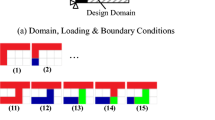Abstract
An automated optimization method based on multipoint approximations and applied to the design of a sheet metal forming process is presented. Due to the highly complex nature of the design functions, it was decided to focus on the characterization of the final product thickness distribution as a function of the preforming die shape variables. This was achieved by constructing linear approximations to the noisy responses usingresponse surface methodology (RSM). These approximations are used to obtain an approximate solution to an optimization problem. Successive approximations are constructed, which improve the solution. An automated panning-zooming scheme is used to resize and position the successive regions of approximation. The methodology is applied to optimally design the preforming die shape used in the manufacture of an automotive wheel centre pressing from a sheet metal blank. The die shape is based on a cubic spline interpolation and the objective is to minimize the blank weight, subject to minimum thickness constraints. A weight saving of up to 9.4% could be realized for four shape variables. Restart is introduced to escape local minima due to the presence of noise and to accelerate the progress of the optimization process.
Similar content being viewed by others
References
Antúnez, H.J. and Kleiber, M. 1996a: Sensitivity analysis of metal forming processes involving frictional contact in steady state.J. Materials Processing Tech. 60, 485–491
Antúnez, H.J. and Kleiber, M. 1996b: Sensitivity of forming processes to shape parameters.Comp. Meth. Appl. Mech. Engng. 137, 189–206
Arora, J.S. 1989:IDESIGN User's Manual Version 3.5.2, Optimal Design Laboratory, College of Engineering, The University of Iowa
Badrinarayanan, S.; Zabaras, N. 1996: A sensitivity analysis for the optimal design of metal-forming processes.Comp. Meth. Appl. Mech. Engrg. 129, 319–348
Balagangadhar, D.; Tortorelli, D.A. 1997: A steady displacement-based formulation for the analysis and design of large deformation continuous elastoplastic manufacturing processes.Proc. 1997 Joint ASME/ASCE/SES Summer Meeting McMU'97 Symp. on Design Optimization with Application to the Industry
Cheng, H.; Grandhi, R.V.; Malas, J.C. 1994: Design of optimal process parameters for non-isothermal forging.Int. J. Num. Meth. Engrg.,37, 155–177
Dang Van, K.; Griveau, B.; Message, O. 1989: On a new multiaxial fatigue limit criterion: theory and application. London:Mechanical Engineering Publications
Etman, L.F.P.; Adriaens, J.M.T.A.; Van Slagmaat, M.T.P.; Schoofs, A.J.G. 1996: Crash worthiness design optimization using multipoint sequential linear programming.Struct. Optim. 12, 222–228
Etman, L.F.P. 1997:Optimization of multibody systems using approximation concepts. Doctoral Thesis, Technical University of Eindhoven
Fourment, L.; Balan, T.; Chenot, J.L. 1996: Optimal design for non-steady-state metal forming processes—II. Application of shape optimization in forging.Int. J. Numer. Meth. Engrg. 39, 51–65
Giunta, A.A.; Dudley, J.M.; Narducci, R.; Grossman, B.; Haftka, R.T.; Mason, W.H.; Watson, L.T. 1994: Noisy aerodynamic response and smooth approximations in HSCT design.Proc. AIAA/USAF/NASA/ISSMO Symp. on Multidisciplinary Analysis and Optimization (held in Panama City Beach, FL)
Grandhi, R.V.; Kumar, A.; Chaudhary, A.; Malas, J.C. 1993: State-space representation and optimal control of non-linear material deformation using the finite element method.Int. J. Numer. Meth. Engrg. 36, 1967–1986
Grandhi, R.V.; Thiagarajan, R. 1994: Model reduction and process control of thermomechanical behaviour of non-linear material deformation.Int. J. Numer. Meth. Engrg. 37, 3135–3152
Han, C.S.; Grandhi, R.V.; Srinivasan, R. 1993: Optimum design of forging die shapes using nonlinear finite element analysis.AIAA J. 31, 774–781
Hibbitt, Karlsson & Sorenson, Inc. 1996:ABAQUS/Explicit user's manual, Version 5.6. Pawtucket, RI
Hibon, G.; Marron, G.; Patou, P. 1996: Light car wheels in high strength steel.Proc. 19-th biennial IDDRG Cong. (held in Eger, Germany)
Kleiber, M.; Hien, T.D.; Antúnez, H.; Kowalczyk, P. 1995: Parameter sensitivity of elastoplastic response.Eng. Computations 12, 263–280
Kok, S.; Stander, N.; Roux, W.J. 1998: Thermal optimization in transient thermoelasticity using response surface approximations.Int. J. Numer. Meth. Engrg. 43, 1–21
Kopp, R. 1996: Some current development trends in metalforming technology.J. Materials Processing Tech. 60, 1–9
Maniatty, A.M.; Chen, M. 1996: Shape sensitivity analysis for steady metal-forming processes.Int. J. Numer. Meth. Engrg. 39, 1199–1217
Marciniak, Z.; Duncan, J.L. 1992:Mechanics of sheet metal forming. Edward Arnold
Myers, R.H.; Montgomery, D.C. 1995:Response surface methodology: process and product optimization using designed experiments. New York: John Wiley & Sons Inc.
Ohata, T.; Nakamura, Y.; Katayama, T.; Nakamachi, E.; Nakano, K. 1996: Development of optimum process design system by numerical simulation.J. Materials Processing Tech. 60, 543–548
Roux, W.J.; Stander, N.; Haftka, R.T. 1996: Response surface approximations for structural optimization.Proc. 6-th AIAA/NASA/ISSMO Symp. on Multidisciplinary Analysis and Optimization (held in Bellevue, WA)
Roux, W.J.; du Preez, R.J.; Stander, N. 1997: The design optimization of a semi-solid tyre using response surface approximations.Engineering Computations 16, 165–184
Roy, S.; Ghoshi, S.; Shivpuri, R. 1997: A new approach to optimal design of multi-stage metal forming processes with micro genetic algorithms.Int. J. Mach. Tools & Manufacture 37, 29–44
Saayman, P.J.; Kok, S.; Roux, W.J.; Stander, N.; Snyman, J.A. 1998: An adaptive successive multipoint approximation method for structural optimization (submitted)
Kleiber, M.; Sosnowski, W. 1995: Parameter sensitivity analysis in frictional contact problems of sheet metal forming.Computational Mech. 16, 297–306
Teracher, P.; Marron, G. 1994: Application of high-strength hot rolled steels in wheels.Proc. Symp. on High-Strength Sheet Steels for the Automotive Industry (held in Baltimore, MD)
Venter, G.; Haftka, R.T.; Starnes, H.S. 1996: Construction of response surfaces for design optimization applications.Proc. 6-th AIAA/NASA/ISSMO Symp. on Multidisciplinary Analysis and Optimization (held in Bellevue, WA)
Wright, E.; Grandhi, R.V. 1997: A shape optimization technique for controlling deformation parameters in forging.Proc. 38-th AIAA/ASME/ASCE/AHS Structures, Structural Dynamics and Materials Conf., pp. 1250–1257
Yamazaki, K.; Han, J.; Ishikawa, H.; Kuroiwa, Y. 1997: Maximization of crushing energy absorption of cylindrical shells — simulation and experiment.Proc. OPTI97 Conf. (held in Rome, Italy)
Zhao, G.; Wright, E.; Grandhi, R.V. 1996: Computer aided preform design in forging using the inverse die contact tracking method.Int. J. Mach. Tools & Manufacture 36, 755–761
Author information
Authors and Affiliations
Rights and permissions
About this article
Cite this article
Kok, S., Stander, N. Optimization of a sheet metal forming process using successive multipoint approximations. Structural Optimization 18, 277–295 (1999). https://doi.org/10.1007/BF01223312
Received:
Issue Date:
DOI: https://doi.org/10.1007/BF01223312




